News
Inept Govt. found woefully wanting in disaster management
View(s):- Opposition decries Govt’s mealy mouthed response to its (mis)handling
- Adjournment Debate on the recent floods, landslides
By Sandun Jayawardana
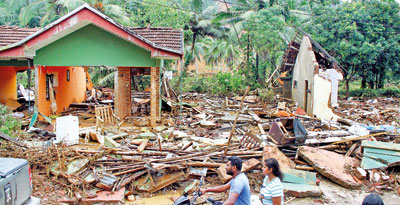
Destroyed homes in Matugama. Pic by Indika Handuwala
A.ccusations that the Govt lacked a proper disaster response mechanism to respond to the recent flood and landslide devastation, were leveled from many quarters of the Opposition, during last Friday’s Adjournment Debate (AD) on the recent devastation.
The AD, requested by the Janatha Vimukthi Peramuna (JVP), saw speaker after speaker from the JVP and the Joint Opposition (JO) decrying the Govt’s response to the crisis.
The AD lasted close to 10 hours, with even the MPs’ lunch break not taken, to facilitate the AD. Govt and Opposition MPs praised the Tri-forces’ contribution to the rescue and recovery efforts. The dedication and commitment of Govt officials, many of whom worked under immense difficulties, while some were victims of the disaster themselves, was also highlighted on either side of the aisle. There was also praise for the work undertaken by religious leaders including monks. That was, however, where consensus ended.
Following are excerpts from speeches made by some Govt and Opposition MPs at the AD:
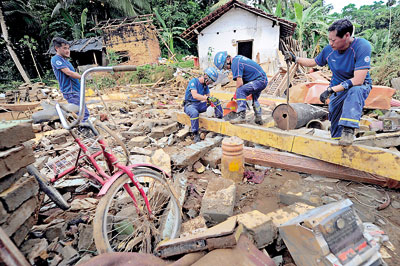
Helping hand: A Chinese team specialising in post-disaster operations at work in Pahiyangala. Pic by Amila Gamage
JVP MP Sunil Handunnetti:
At least 292 persons have now been confirmed as either dead or missing due to the disaster. The main question is, could we not have saved these lives, if we had a stronger mechanism to warn people and evacuate them from the danger zones?
The Disaster Management Centre (DMC ) was there to distribute relief after the disaster. There is no point in having a disaster management mechanism simply to go and distribute relief goods to people, after a disaster has occurred.
As a country, it should be a matter of immense regret to us that, we were not able to quickly identify landslide prone areas where over 150 mm of rain fell, and evacuate people to safety before the landslides occurred.
What sort of mechanism was in place to warn people of impending disasters, in order to minimise loss of life, and was that mechanism adequate?
In addition, there is no proper mechanism to ensure that flood-waters are diverted to the sea, via the country’s main rivers. For example, Matara town flooded because there was no mechanism to ensure that adequate water was diverted from the mouth of the Nilwala River to the sea.
Even when it came to post-disaster relief efforts, the only mechanism in place through District and Divisional Secretariats is to issue relief goods through Grama Niladharis. Furthermore, there is no programme in place to enable people rise again in a post-disaster environment.
According to current figures, the Govt needs over Rs 8.8 billion, simply to provide compensation for deaths caused by the disaster, and for totally damaged houses. However, only Rs 278 million has been released for compensation. When will the Govt release the rest of these funds, and how will it be disbursed among the victims?
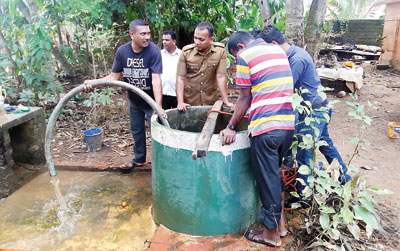
Cleaning wells in Kalutara. Pic by Sarath Siriwardene
Most District and Divisional Secretariats in affected areas did not possess boats required for rescue and relief efforts. This despite many of these areas being affected by a similar massive flood in 2003.
Minister of Disaster Management (UPFA): Anura Priyadarshana Yapa,Accusations that the Govt took no action to alert people are false. People were alerted through the DMC. Loudspeakers were used in many places to warn people in danger zones, according to District and Divisional Secretaries. Some people ignored these warnings and it cost them their lives, but the warnings also helped to save people. We only speak of lives that were lost, but lives were also saved.
I must also firmly reject allegations that the Govt’s DM plan was a failure. Tri-forces personnel were at the forefront of the disaster rescue and relief efforts. Govt officials from the District and Divisional Secretaries also put in an enormous effort, as part of the State mechanism.
I do accept that we did not have any designated relief centres to be utilised during times of disaster. As of now, places such as community centres and places of worship are being used for such centres. As part of an Asian Development Bank project, we have started building designated centres in Gampaha, Badulla and Kegalle, to be expanded later.
I also acknowledge that many people are still being housed in welfare camps, as their houses were destroyed in the devastation. In order to provide relief to them, I will present a Cabinet paper soon to release funds to such families, so that, they can rent houses until new houses can be built for them.
Every individual in the country is insured under a disaster relief coverage, and there won’t be any issues in providing compensation to the victims. We can recover the funds via the Insurance Trust Fund. While I agree with Members of the Opposition that, compensation of Rs 100,000 for the family of deceased person may be insufficient, the Govt would do its utmost to increase the amount.
Opposition Leader (ITAK) R. Sampanthan:
I must question whether the Central Govt in Colombo is adequately equipped to handle such situations in various parts of the country. I also want to pose a question whether there is a lack of genuine and serious practical commitment to handle such situations when they occur in various parts of the country.
I believe, it would be better for some of these issues to be handled at provincial level, where there is greater interaction between the people and these institutions and, consequently, there is every opportunity for more expeditious action to pre-empt these things happening or, to deal with them as they occur.
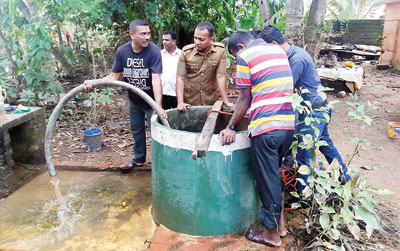
Matara: A Buddhist monk has to travel by boat to attend to last rights of a deceased during heavy flooding. Pic by Krishan Jeevaka Jayaruk
Water Supply & Drainage Minister (UNP) Rauff Hakeem:
Half of the Matara district was affected by the recent devastation. Despite this, farmers in the region have firmly resisted moves to divert water from the Nilwala River, suspicious that the move will deprive them of water for their crops. It is now time to hold discussions with the farmers, people’s representatives and others in the region to find a durable solution.
I propose that a separate agency with broad authority be established, to protect river basins and river valleys. I even made such a proposal to Cabinet earlier but, it was scuttled in the face of objections to it from various subject ministers.
Chief Government Whip and Minister of Lands and Parliamentary Reforms (UNP) Gayantha Karunatileka:
Our main task now is to find alternate lands for those who have been displaced by the disaster. As the new Minister of Lands, I would like to convey a message to those residing on dangerous lands in the hills. It is time you come down. You have lived with danger long enough. Please make up your minds to leave those areas. I pledge that, we will find you safer areas to resettle in.
Minister of Ports and Shipping (UPFA) Mahinda Samarasinghe
In the Kalutara District, 187,883 persons were affected by the disaster. We had the worst death toll from natural disaster in history, with 65 confirmed dead and 50 missing.
Bulathsinhala Secretariat Division was the worst hit with 55,609 persons from 15,098 families affected by floods and landslides in that area. Of the 65 confirmed deaths in the District, 37 were from Bulathsinhala, while 42 of the missing were also reported from there. Palindanuwara had 23 deaths.
We now have a responsibility, not only to provide relief and compensation to the victims, but also to help them get back on their feet. I applaud the decisions taken by the Disaster Management Ministry to build houses for these people in locations certified safe by the National Building Research Organization (NBRO). We must think about the security of the victims when helping them to rebuild.
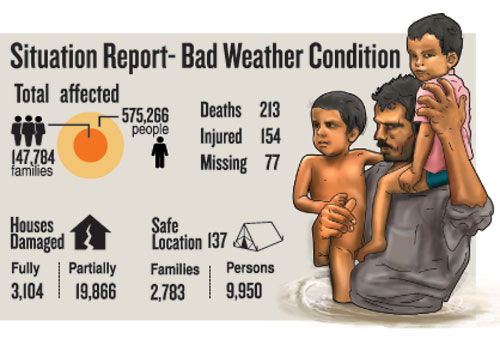 As we move forward, we must give priority to a mechanism aimed at minimising the impact from natural disasters.
As we move forward, we must give priority to a mechanism aimed at minimising the impact from natural disasters.
Dullas Alahapperuma (UPFA) :
While we applaud the services rendered by Govt officials, it is a fact that, during the crucial first hour, as the disaster was unfolding, the State machinery had been inactive. It fell on society and the media to fill the void.
For example, we visited Morawaka in Matara, on May 29, three days after the landslide there. We found that the Divisional Secretary did not possess a single mat to provide for the displaced and had only 60 plates. This was not her fault. The delay was due to Govt officials not receiving sufficient funds to purchase the required items. Pregnant women were sleeping on the cold floor ,without so much as a mat or a pillow. In the end, our JO MPs purchased mats, mattresses, pillows and plates for the displaced, as these were urgently needed.
While one could not prevent natural disasters, they could still be effectively managed. However, Sri Lanka still does not possess an effective disaster management system.
I propose that, if the country does not possess the scientific capabilities to predict rains in excess of 150mm, as Met Dept officials acknowledge, there is nothing wrong in outsourcing the subject to external entities which possess the technology to do so.
I must also point out that, during the short span of a 30-month period beginning November 2014, we have experienced eight major disasters. We are in an extremely dangerous situation.
Deputy Minister of Power and Renewable Energy (UNP) Ajith P. Perera:
We must understand that, this was no ordinary flood or landslide disaster. As an MP from the Kalutara District which was severely affected by the disaster, I also agree with my colleagues that disaster preparedness should be at a higher level in such a place. If we take the Kukuleganga power plant area as an example, it experienced over 553 mm of rain over a 24-hour period, and was cut off for three days, with communication channels also breaking down. As such, we should have helipads and boats with powerful outboard motors located in vulnerable areas.
I would also like to propose that, observation posts be set up in identified danger areas and an alarm system put in place to warn residents residing downstream.
Vasudewa Nanayakkara (UPFA):
This entire claim, that the Govt will remove people from danger zones and resettle them elsewhere, has become a joke. In the Ratnapura District which I represent, alternate lands were identified to resettle people who were displaced by the previous floods. But the Govt has not been able to acquire these lands until now. The Govt is not serious in resettling anyone.
| 23,000 houses damaged, 70,000 acres destroyed, 213 dead, 77 missing Nearly 23,000 houses have either been completely or partially damaged, in floods and landslides, initial investigations have revealed. The death toll stood at 213, with 77 listed missing, as of yesterday, with authorities conceding there is no chance of finding any of them alive, meaning, the disaster had cost 290 lives. A total of 9,950 persons from 2,783 families continue to stay in 137 camps throughout the affected Districts. Minister of Home Affairs Vajira Abeywardena said that, the Districts have a large number of areas where the displaced cannot return to their homes or, be resettled, forcing the Govtt to find alternative land. The largest extent of land destroyed is 20,000 acres in the Matara district, followed by Galle, Ratnapura and Kalutara where, about 15,000 acres in each have been destroyed.The estimated damage by floods and landslides are to be included in a final report scheduled to be ready by next Thursday . However, initial estimates indicate the Govt will need up to Rs 8 billion for the reconstruction of houses and to rebuild the infrastructure including roads, schools, State buildings and power lines. “One of the major causes for the floods has been identified as the lack of a flood management programme in the Gin River, Kalu River and Nilwala River,” Mr Abeywardena explained. He said that, as far back as the 1960’s, the US government proposed the construction of six dams, which had not been heeded. “Other offshore areas around the island would also be rough, as wind speeds could increase to 50 kmph at times,” it further warned. “The good news though, is that, only light rain is expected in the country for the next four days at least,” said Duty Meteorologist Nimal Bandara. “Those still without power are in areas affected by severe landslides, with many in camps. We cannot move to restore our transformers there, as these are still danger zones. We also don’t know if people will be resettled in these places again,” Mr Jayawardena explained. Chairman- National Water Supply & Drainage Board, Alahudeen Ansar said water supply was restored within three to four days in most affected areas, and there were no major issues now. | |

